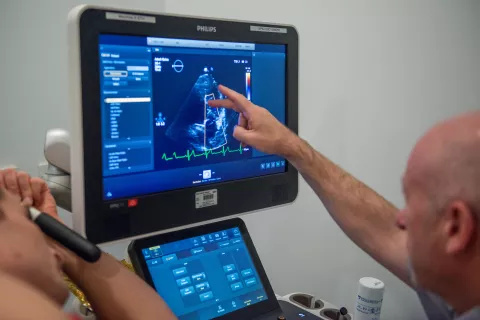Test can give hope to thousands with suspected angina
Monday 18 November 2019

A routine test could help diagnose thousands of people who have ‘microvascular angina’ – abnormalities in their small arteries, according to a study by researchers at Guy’s and St Thomas’ NHS Foundation Trust and King’s College London.
The study was funded by the British Heart Foundation and supported by the NIHR Guy’s and St Thomas’ Biomedical Research Centre. The condition mostly affects women, who are less likely than men to have large artery blockages as the cause of angina.
Angina is a sensation of chest tightness or pressure, which typically occurs during exercise or mental stress. It is not usually life threatening, but could indicate that a patient might need treatment or to make lifestyle changes to avoid complications.
The research shows that using a drug called adenosine during an angiogram – a type of X-ray used to examine blood vessels, can detect microvascular angina.
Approximately 250,000 angiograms are carried out every year in the UK. Around 40% of patients who undergo angiography to diagnose the cause of angina are found not to have narrowing of the large arteries. This means that the test could give a clear diagnosis to around 100,000 people every year, who are currently left uncertain about the cause of their chest pain or are subjected to multiple tests in a bid to find an answer.
The research, published in the journal Circulation, showed that the bodies of healthy individuals adapt to exercise by providing blood to the heart more efficiently. In contrast, the bodies of patients who have microvascular angina are unable to increase blood supply in response to demand.
Doctors could use adenosine to mimic the effects of exercise during angiograms, to ensure that they recognise angina caused by abnormal function of the small arteries.
Professor Divaka Perera, consultant cardiologist at Guy’s and St Thomas’ and professor of interventional cardiology at King’s College London, led the research. He said: “Angina is caused by a lack of blood supply to the heart during exercise. We have historically only looked at angina in terms of finding blockages in the large heart arteries, however, nearly half of all coronary angiograms do not reveal any blockages in blood vessels. We have shown that using medication, we can diagnose the presence of ‘microvascular angina’. We know that this condition is more common in women, and associated with poorer outcomes for patients.
“Our study has given us new and useful insight into what is happening to these patients during exercise, and we hope that this will not only help us pick up the condition better, but that it could help us develop personalised treatments. The more we can understand these different subtypes of angina, the more we can help ensure that these patients are managed appropriately to reduce angina and improve their quality of life.
Professor Jeremy Pearson, Associate Medical Director at the British Heart Foundation, said: “Microvascular angina isn’t a straightforward condition to identify. Despite the common symptoms - chest pain or discomfort which spreads to the jaw, down the arms, to the shoulders, stomach and back and shortness of breath – people often have to go through multiple medical tests over a prolonged period of time, causing a lot of unwanted stress. This new test has the potential to speed up the wait from symptoms to diagnosis, ultimately giving people quick access to the treatment they urgently need.
“This study shows for the first time that microvascular angina may be due to one of two different underlying processes in the blood vessels – either a result of complications to their structure or the way they normally work. These findings imply that we may be able to offer more effective treatments that are better tailored to the specific cause of an individual’s microvascular angina.”
Last updated: March 2022
Contact us
If you're a journalist and have a media enquiry, please contact us.
Phone: 020 7188 5577
Email: [email protected]